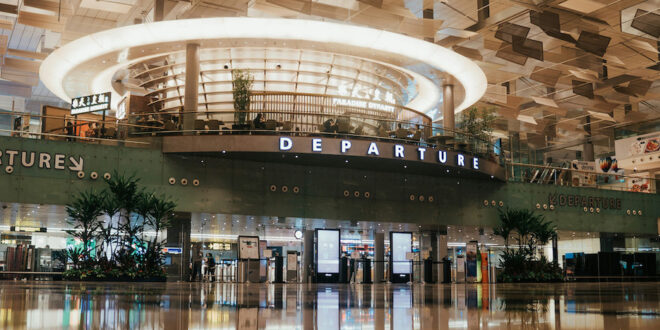 Article extracted from The Secret Life of Flying by Captain Jeremy Burfoot, Pan Macmillan, RRP $39.99
Article extracted from The Secret Life of Flying by Captain Jeremy Burfoot, Pan Macmillan, RRP $39.99
Let’s start at the departure gate. You’ve navigated check-in – and border controls and duty-free shopping if you’re flying internationally – and have put your clothes back on after being forced to get almost naked at security (and if you were clever, you will have upgraded your phone and shoes here too). Now you’re in that state of suspended animation, waiting for the boarding announcement that will start your journey.
If you look out the window, you will see feverish activity going on around your aircraft. This is all done by ground workers, and it’s not very glamorous. Inside the terminal, you only see the more glamorous side of aviation, such as the cafes, overpriced boutiques, pilots strutting around like peacocks and flight attendants done up to the nines. There’s a whole other world going on outside the terminal.
Every aircraft you see at the airport requires a ground crew to maintain it and get it back into the air. On one of the large double- decker four- engine planes, such as the Boeing 747 or the Airbus A380 – ranked in rough order of pay scales, from low at the top end to sweatshop at the bottom – there are aircraft engineers (2), refuelers (1), ramp supervisors (2), security people (3), bus drivers (it depends), people who wreck and lose your bags (5), catering crew (8), people who empty the poo from your aircraft (1) and aircraft cleaning crew (12).
What do I, a former pilot who used to strut around the airport like a peacock, know about ground crew, you ask? Besides actually talking to them throughout my career, for a while after Covid grounded my career as a pilot, I took a refuelling job at Auckland Airport to get an idea of how the ground operations work for a consulting company I had started up.
About the time I got the refuelling job, I was also offered a job sitting in a car at the airport all day trying to catch other ground workers out for breaking the rules. The girl who phoned me said, ‘With your experience in aviation as an A380 captain, you’d fit in well with this job, and we’d like to reward you with minimum wage.’ I’m not sure why a job as an A380 captain made me so qualified, but I wasn’t tempted and politely declined.
One thing I noticed in my time on the tarmac is that a lot of the workers, many of whom are new due to the recruitment boom that happened post-pandemic, don’t have the right level of experience or safety nous, and as a result, many shonky and dangerous things go on that will cost the airlines, over time, with injuries and flight delays.
But here’s the thing. These ground workers, whom you are mostly unaware of, have families and bills to pay just like you, but most are on minimum wages. That’s so you can fly somewhere for a lot less than you should be paying, or so airline executives can be paid their bonuses (you choose). These are real people doing good and sometimes dangerous work, mainly for no thanks. But as Winston, a poo tanker guy, said to me once, ‘At least it’s a job in aviation, and my parents are very proud of me.’ Winston’s parents don’t know exactly what he does. All they know is that he is an evacuations specialist, and Winston is the first there if the shit ever hits the fan.
The enthusiasm on the tarmac is infectious, which shows the calibre of the people there. The ground workers I’ve had dealings with, in my career, are a fun and happy bunch who constantly work with a smile. Of course, they could get almost as much money on a benefit, but they aren’t and kudos to them for that.
When an aircraft arrives at the gate for a short turnaround, it’s like a tyre change and refuel for a Formula 1 car. It’s controlled mayhem. The only way it gets done on time is for everyone to charge around at breakneck speed and do things that aren’t always safe. I discussed this with my refuelling boss and asked if the process was ever audited. He said, ‘Yes. But management, who have KPIs for good audit results, tell everyone in advance when it will happen, so they never fail.’
To be more specific about the dangers of working on the ground, we are talking about multiple vehicles driving around at speed in all weather and often in the dark. Apart from vehicles, there are all sorts of loading equipment being used to move and lift heavy containers. Being run over or having body parts crushed is not uncommon. Sadly, even being sucked into running jet engines is not unheard of.
I know how much you all hate flight delays, so this needs to be fixed, but I’m not sure what the answer is. If I was running the place, I’d pay them a bit more, encourage loyalty and make them stakeholders in the safety culture of the company. That would be a good start, at least.
In other news from the ground operation, I have seen why your bag sometimes doesn’t turn up and other times turns up wet. Some smaller aircraft, like the Boeing 737, load all bags into a bulk baggage hold by hand, off a trolley which is towed from the terminal stacked to the sky with your bags. Frequently they fall off en route. The tow tractor doesn’t have rear- vision mirrors, so unless the driver is Linda Blair, they won’t see your bag fall off. If it rains, all the bags on top of the pile get wet. Larger aircraft tend to have bags loaded in semi- waterproof containers, which is a much better system.
Around 0.5 per cent of all bags get lost on average worldwide. That means 1 in 200. On a B737, that’s one bag on each flight. Three on a B747. That’s 25 million bags worldwide per year. It is said that the rings of Saturn are made up of lost airline bags, which explains why the rings are so visible. The good news is that the percentage of lost bags has halved in the last 15 years. Apparently, 16 per cent of misplaced bags are a result of the wrong tag being put on a bag, so that’s something you can check yourself before you bid your bag farewell at the check-in counter.
Since I did the refuelling gig for a while, it would be remiss of me not to explain how that works. In most big airports, fuel is pumped under pressure through a large underground pipe to hydrants in the tarmac. The refueller drives his truck under the wing, gets out and runs all sorts of wires as if the aircraft is getting an ECG. He plugs into the hydrant at one end and the refuelling points under the aircraft wing at the other end, then allows the pressure from the hydrant to push fuel into the aircraft. The truck and its systems are really only a metering unit. The system is capable of up to 4,000 litres per minute if the aircraft will accept that much. It’s pretty impressive.
Pets get a bum deal flying by air. The environment around the aircraft’s outside is as noisy as a mosh pit at a Nirvana concert. Workers are supposed to wear earmuffs and sometimes earplugs as well. But pets are often left on the tarmac in this noise for long periods of time. They are not even offered earmuffs; if they were, they probably wouldn’t wear them because they’d feel self-conscious. So, if your cat ignores you after a flight, don’t take it personally. It’s just deaf.








Join the Discussion
Type out your comment here:
You must be logged in to post a comment.